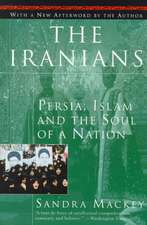Intifada: Palestine at the Crossroads
Autor Roger Heacock, Jamal Nassaren Limba Engleză Hardback – 25 mar 1990 – vârsta până la 17 ani
Preț: 442.31 lei
Preț vechi: 606.76 lei
-27% Nou
Puncte Express: 663
Preț estimativ în valută:
84.65€ • 88.26$ • 70.35£
84.65€ • 88.26$ • 70.35£
Carte tipărită la comandă
Livrare economică 21 martie-04 aprilie
Preluare comenzi: 021 569.72.76
Specificații
ISBN-13: 9780275934118
ISBN-10: 027593411X
Pagini: 360
Dimensiuni: 156 x 235 x 34 mm
Greutate: 0.76 kg
Ediția:New.
Editura: Bloomsbury Publishing
Colecția Praeger
Locul publicării:New York, United States
ISBN-10: 027593411X
Pagini: 360
Dimensiuni: 156 x 235 x 34 mm
Greutate: 0.76 kg
Ediția:New.
Editura: Bloomsbury Publishing
Colecția Praeger
Locul publicării:New York, United States
Notă biografică
JAMAL R. NASSAR is Associate Professor of Political Science at Illinois State University. He was Senior Fulbright Scholar at Bir Zeit University on the West Bank.ROGER HEACOCK is Assistant Professor of History at Bir Zeit University. He has taught and published in the field of Modern European and International History.
Cuprins
PrefaceIntroduction: On Achieving IndependenceThe PreconditionsThe Sociology of an Uprising: The Roots of the IntifadaThe Effects of Israeli Occupation on the Economy of the West Bank and Gaza StripThe Development of Political Consciousness Among Palestinians in the Occupied Territories, 1967-1987The Emergence of an Infrastructure of Resistance: The Case of HealthThe ParticipantsThe Role of Refugee CampsJeep Versus Bare Feet: The Villages in the IntifadaFrom Salons to the Popular Committees: Palestinian Women, 1919-1989Work and Action: The Role of the Working Class in the UprisingThe Revolt of the Petite Bourgeoisie: Urban Merchants and the Palestinian UprisingThe Islamic Movement and the IntifadaThe Revolutionary Transformation of the Palestinians Under Occupation"Discontented People" and "Outside Agitators": The PLO in the Palestinian UprisingRegional and International ReactionsA Symmetry of Surrogates: Jordan's and Egypt's Response to IntifadaThe Intifada in American Public OpinionThe European Community and The Middle East ConflictImpact on the Main ProtagonistsThe Third Factor: Impact of the Intifada on IsraelPalestinian Elites in the Occupied Territories: Stability and Change Through the IntifadaConclusionThe Future in Light of the PastAppendixSelected BibliographyIndex














